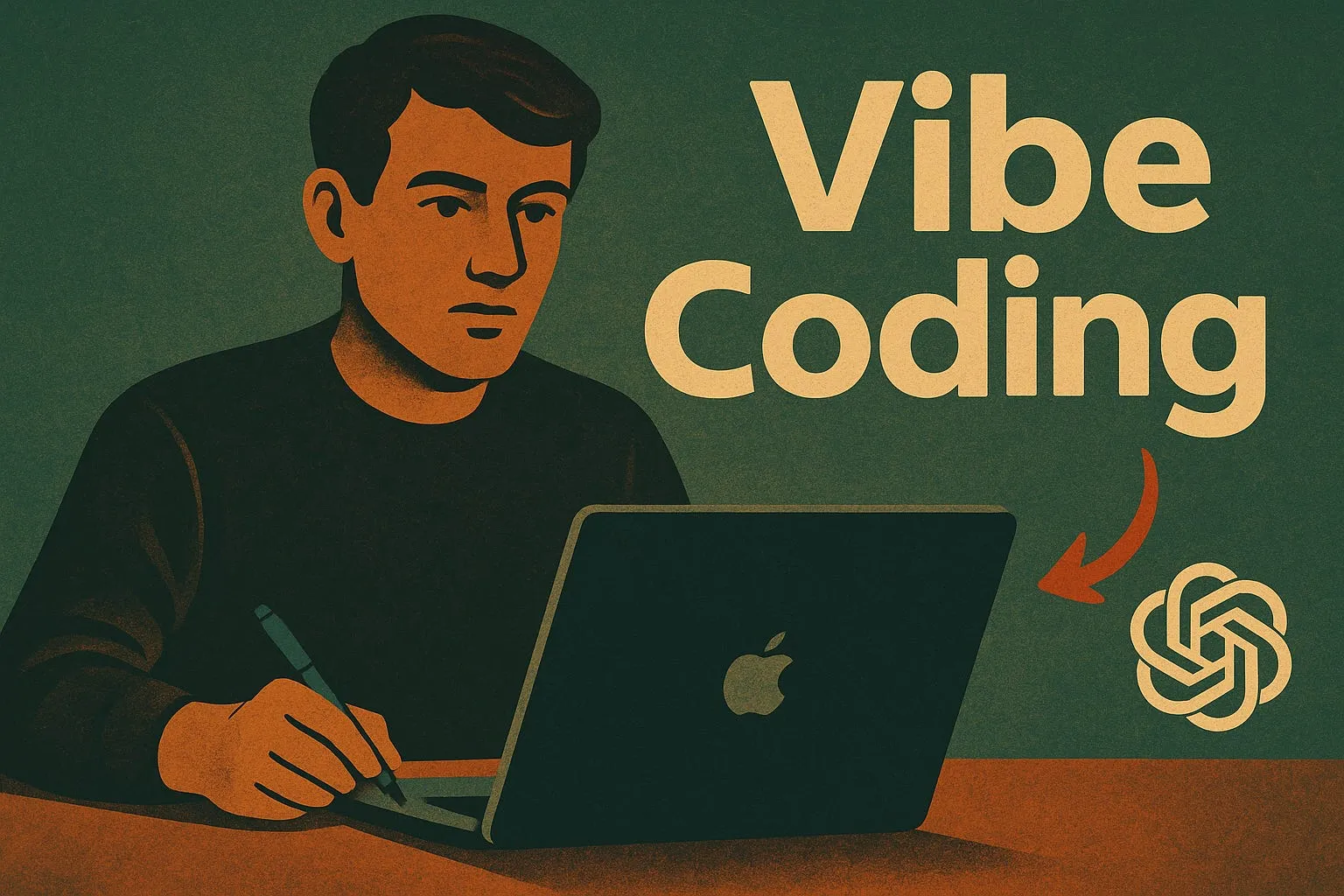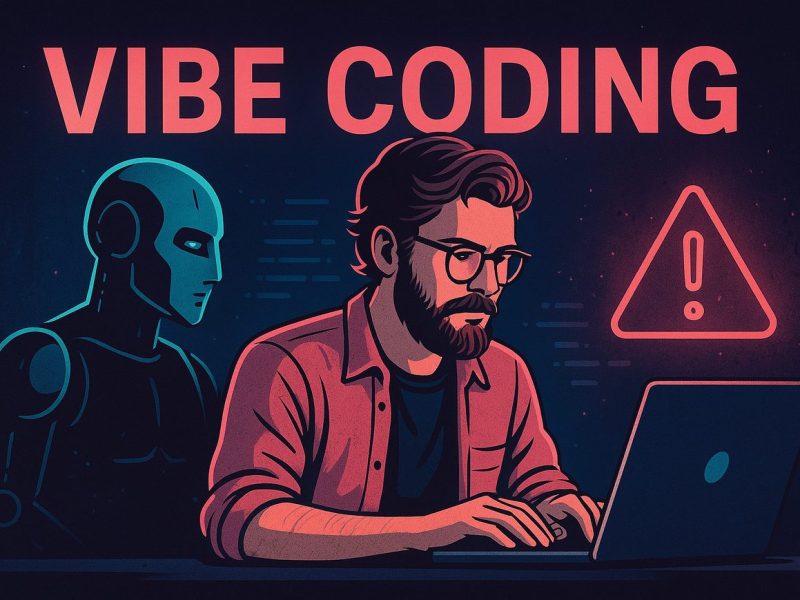Core Principles, Practices, and Tools Transforming Software Development
Introduction: The Paradigm Shift in Creation
Imagine describing a web application in plain English—”Build a responsive Pomodoro timer with dark mode and analytics”—and watching functional code materialize instantly.
This is vibe coding, the AI-driven methodology revolutionizing software development. Coined by AI researcher Andrej Karpathy in 2025, vibe coding transcends traditional programming by treating natural language as the primary interface between human intent and machine execution.
For UX designers and architects like us, this represents more than a productivity boost—it’s a fundamental shift in how we translate vision into reality.
Industry data reveals staggering impacts: Teams leveraging vibe coding report 10–100x productivity gains, with AI generating over 95% of their codebase. But beneath the hype lies a disciplined framework grounded in four core principles we’ll dissect in this guide.
Core Principle 1: Human-AI Pair Programming
Beyond Tools to Collaborative Partnership
Unlike traditional coding, vibe coding positions AI (e.g., GPT-4, Claude, Gemini) as an active “junior developer” that interprets high-level goals into executable code. This partnership follows three key practices:
The Requirements Interview: Begin projects with structured conversations to define scope:
“Act as an expert product manager. Ask questions to clarify my Pomodoro timer app until we have an MVP blueprint.”
This dialogue surfaces edge cases (e.g., “Should breaks auto-start?”) before writing a single line.Constitutional Prompting: Transform outputs into reusable directives:
## Project Constitution - Vision: Minimalist focus timer - Do Not Touch: Never hardcode API keys - Core Rules: Customizable work/break intervals - Key Patterns: [Updated iteratively]
Tools like Claude Code use
CLAUDE.mdto enforce these rules context-wide.Role-Driven Workflow: Humans act as navigators (strategists); AI serves as the driver (executor). For example:
Human: “Implement JWT auth in Node.js following our security patterns.”
AI: Generates code + explains encryption choices.
Tools & Workflows:
GitHub Copilot (VS Code integration)
Cursor (AI-native IDE)
SynergyAI (visual dataflow programming)
Architect’s Insight: Treat prompts like product specs—ambiguity invites technical debt. Specify libraries, error-handling rules, and architecture constraints upfront.
Core Principle 2: Flow State over Precision
Optimizing for Creativity, Not Syntax
Vibe coding prioritizes momentum over perfection. Studies show developers spend 35% of time debugging syntax errors —a drain eliminated by AI handling boilerplate. This enables:
Rapid Prototyping: Build functional MVPs in hours, not weeks. One developer created DaddyTime—a weather-integrated activity finder—in 30 minutes via CursorAI.
Experimental Freedom: Test libraries or APIs without setup overhead. Prompt: “Compare accuracy of TensorFlow vs PyTorch for image classification on this dataset”.
Balancing Speed and Quality:
Do: Use AI for scaffolding (component templates, CRUD endpoints).
Don’t: Delegate complex logic unsupervised. A Microsoft engineer warns AI often “gets lost in requirements, generating nonsense” when unguided.
Flow Preservation Tactics:
Isolate Tasks: Dedicate chats to single features (e.g., “Fix navbar responsiveness”) to avoid context overload.
Meta-Cognition Prompts: When stuck, command: “Pause. List edge cases for this password flow before coding”.
Tools: Replit Ghostwriter (browser-based), Vitara.AI (prompt versioning).
Core Principle 3: Accessibility First
Democratizing Development
Vibe coding demolishes barriers: 75% of Replit users now build applications without writing code. Key enablers:
Natural Language Interfaces: Describe functions plainly—“Scrape Amazon product prices into Google Sheets”—to generate Python scripts.
Inclusive Design:
Tools enforce WCAG standards via auto-added ARIA tags.
Screen reader-compatible outputs (e.g., using
<table>for address data).
Real-World Impact:
Non-technical teams at companies like IBM build internal tools (e.g., HR dashboards) using prompts alone. Meanwhile, designers prototype in Framer via text commands, bypassing developer dependencies.
Accessibility Tools:
Axe-core (automated audits)
NVDA/JAWS (screen reader testing)
IBM watsonx Code Assistant (enterprise-grade generation)
UX Warning: Accessible output ≠ accessible process. Always test AI-generated UIs with tools like Fable (user testing with disabilities).
Core Principle 4: Iterative Refinement
The Conversational Feedback Loop
Vibe coding treats development as a dialogue: Prompt → Code → Critique → Repeat. For example:
“Build a REST API for user management” → Generates basic endpoint.
“Add rate limiting and Swagger docs” → Enhances code.
“Optimize SQL queries” → Refines performance.
Critical Practices:
Verification Rigor: Test every AI output. A 2025 study found 41% of AI-generated Python scripts had security flaws (e.g., hardcoded credentials).
Debugging Commands: Use “Print intermediate values to debug this function” to expose hidden failures 1.
Architectural Oversight: AI builds features; humans ensure scalability. Example prompt: “Convert this script into microservices with RabbitMQ messaging”.
Tools:
Diamond (automated code review for AI outputs)
Jest/Vitest (AI-generated unit tests)
Challenges & Mitigations
Vibe coding introduces novel risks—here’s how to counter them:
Technical Debt: AI’s “code-first” approach often ignores maintainability.
Fix: Adopt hybrid workflows—prototype with AI, then refactor manually.
Context Collapse: LLMs struggle with 1,000+ line codebases.
Fix: Modularize projects; use tools like Cursor’s codebase indexing.
Security Gaps: AI may suggest vulnerable patterns (e.g., SQL injection).
Fix: Constitutional prompts like “NEVER concatenate SQL strings”.
Table: Vibe Coding vs. Traditional Development
| Aspect | Vibe Coding | Traditional Coding |
|---|---|---|
| Speed | MVP in hours | Weeks-months |
| Maintainability | Requires oversight | Direct control |
| Accessibility | Enables non-coders | High technical barrier |
| Best For | Prototypes, internal tools | Scalable, secure systems |
The Future Evolution
Vibe coding is evolving toward:
Multimodal Interfaces: Voice/gesture-based coding (e.g., “Zoom this component via hand wave”).
VibeOps: AI-managed deployment pipelines auto-patching bugs.
Enhanced Context: Models retaining organizational knowledge across projects.
Conclusion: The New Division of Labor
Vibe coding doesn’t replace developers—it redefines their role. As AI handles syntax, human value shifts to:
Strategic Architecture (designing systems, not functions)
Quality Assurance (rigorous testing, ethical oversight)
Problem Selection (solving impactful challenges)
Start your transition today:
Experiment with Cursor or Replit.
Document foundational prompts.
Audit AI outputs with Diamond or axe-core.
Upskill in prompt engineering & system design.
“The AI builds bricks with speed; you design the cathedral.”
Explore Further:


